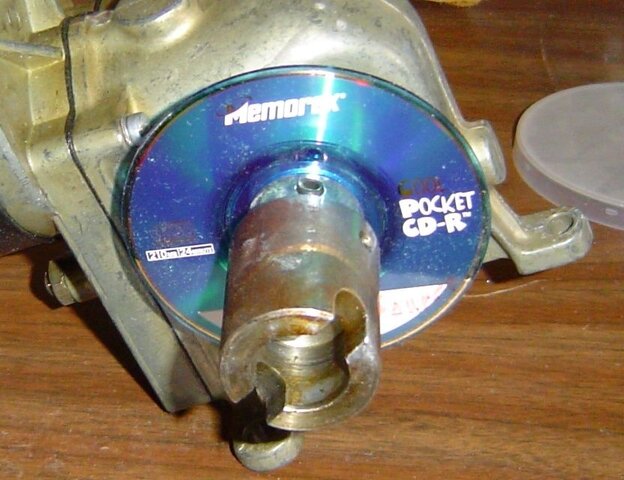If I recall correctly, we thought the Gbox would do 4000 total, and the Vbox 2 would do 2000 total.
(Gbox = plus or minus 2000; Vbox = plus or minus 1000)
Problem is, the Gbox appeared to count on the contact closure and the contact opening of your reed switch.
(based on my understanding of the fine work Linuxman did)
So, while the Gbox certainly gave you twice as many reliable places to stop your dish, and that does increase accuracy, you still have a limited count-range that is essentially the same for both boxes.
That's why I was suggesting the lower count rate from your AMTencoder.
Now ... you know the number of turns the mechanism makes.
You know from the tables I presented above how many counts per turn the AMT can offer.
And you know the total count of Vbox=2000 or Gbox=4000, but with a caveat.
You should be able to select a count rate PPR (pulses per revolution) that'll maximize your counts without overflowing either box.
Also, in real life, you won't be running the mechanism from end to end, so if you'll read Linuxman's threads referenced above, you'll see how many counts he gets between his East and West limits.
Recap:
#1. I would certainly entertain the AMT.
It apparently has great potential.
You need to decide if it'll fit in the available space within the motor housing, up against the gears.
#2. The magnetic disc (I'd glue it on) is a winner.
From Linuxman's comments he seems to have a very strong 24-pole magnetic wheel and a reed switch.
I'm surprised this can work, but apparently it does.
His friend is right: looks like $20 worth of parts.
You would have to rig a way to mount the reed and keep it stationary, but I don't see that being a major problem.
Maybe the one you bought would work, if you got the strongest of magnetic discs...
#3. Personally, I'd look at using a hall-effect chip reclaimed from a dead PC-fan motor.
They are free, in unlimited supply (if I haven't thrown out all my dead fans), small, and low power.
The trick again would be mounting it, but I can see sticking it to a popsicle stick, and then flowing some epoxy overcoat onto it!
This would be a little less robust than a reed switch, but would last forever (if you didn't mess up your wiring).
#4. Having worked on projects with optical sensors before, I have a bad taste in my mouth from them.
I can envision all sorts of long-term failure modes (mostly concerned with small insects and dust).
Of course, those projects were a lot more touchy than just a simple on/off reading from a hole/slot in an opaque disc.
So, I'm not totally against perusing that line of thinking... but I think any of the ideas above would be preferable.
(Gbox = plus or minus 2000; Vbox = plus or minus 1000)
Problem is, the Gbox appeared to count on the contact closure and the contact opening of your reed switch.
(based on my understanding of the fine work Linuxman did)
So, while the Gbox certainly gave you twice as many reliable places to stop your dish, and that does increase accuracy, you still have a limited count-range that is essentially the same for both boxes.
That's why I was suggesting the lower count rate from your AMTencoder.
Now ... you know the number of turns the mechanism makes.
You know from the tables I presented above how many counts per turn the AMT can offer.
And you know the total count of Vbox=2000 or Gbox=4000, but with a caveat.
You should be able to select a count rate PPR (pulses per revolution) that'll maximize your counts without overflowing either box.
Also, in real life, you won't be running the mechanism from end to end, so if you'll read Linuxman's threads referenced above, you'll see how many counts he gets between his East and West limits.
Recap:
#1. I would certainly entertain the AMT.
It apparently has great potential.
You need to decide if it'll fit in the available space within the motor housing, up against the gears.
#2. The magnetic disc (I'd glue it on) is a winner.
From Linuxman's comments he seems to have a very strong 24-pole magnetic wheel and a reed switch.
I'm surprised this can work, but apparently it does.
His friend is right: looks like $20 worth of parts.
You would have to rig a way to mount the reed and keep it stationary, but I don't see that being a major problem.
Maybe the one you bought would work, if you got the strongest of magnetic discs...
#3. Personally, I'd look at using a hall-effect chip reclaimed from a dead PC-fan motor.
They are free, in unlimited supply (if I haven't thrown out all my dead fans), small, and low power.
The trick again would be mounting it, but I can see sticking it to a popsicle stick, and then flowing some epoxy overcoat onto it!
This would be a little less robust than a reed switch, but would last forever (if you didn't mess up your wiring).
#4. Having worked on projects with optical sensors before, I have a bad taste in my mouth from them.
I can envision all sorts of long-term failure modes (mostly concerned with small insects and dust).
Of course, those projects were a lot more touchy than just a simple on/off reading from a hole/slot in an opaque disc.
So, I'm not totally against perusing that line of thinking... but I think any of the ideas above would be preferable.




